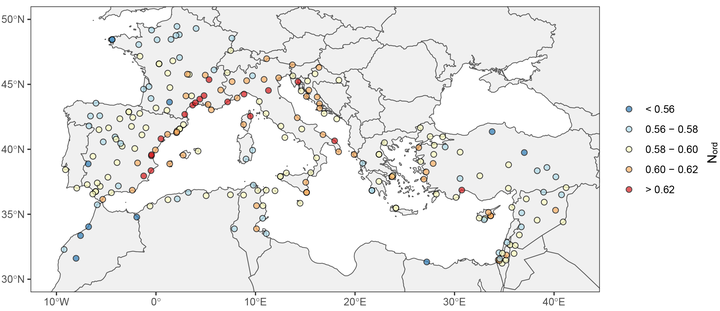Spatiotemporal variability of daily precipitation concentration and its relationship to teleconnection patterns over the Mediterranean during 1975-2015

Abstract
This study has addressed the spatiotemporal distribution of the daily rainfall concentration and its relation to the teleconnection patterns across the Mediterranean (MR). Daily Concentration Index (CI) and the ordered n index () are used at annual time scale to reveal the statistical structure of precipitation across the MR based on 233 daily rainfall series for the period 1975–2015. Eight teleconnection patterns ,North Atlantic Oscillation (NAO), Mediterranean Oscillation (MO), Western Mediterranean Oscillation (WeMO), Upper Level Mediterranean Oscillation index (ULMO), East Atlantic (EA) pattern, East Atlantic/West Russia (EATL/WRUS) pattern, Scandinavia (SCAND) pattern and Southern Oscillation (SO) at annual time scale are selected. The spatiotemporal patterns in precipitation concentration indices, annual precipitation and their teleconnections with previous large-scale circulations are investigated. Results show a strong connection between the CI and the (r = 0.70, p<0.05) which present the same relative areas of high and low concentration. The annual values range from 0.57 to 0.70 for CI and 0.49 to 0.71 for index which show a high daily precipitation concentration across the MR. Trend analysis demonstrated mostly significant increasing trends for both indices. This increase is mainly found in south France, northern coastlands of the Iberian Peninsula (IP), Greece and Tunisia. An inverse relationship between the number of rainy days and concentration indices is evident. Both of WeMO and MO can play an important role in modulating rainfall in the northwest Mediterranean. The positive EATL/WRUS phase is mainly connected with positive precipitation mean anomalies in the Eastern Mediterranean and vice versa in the west. The high daily precipitation concentration values over south France, northeast Spain, Croatia and Tunisia are linked to the low values of WeMO and high values of EA. These results could pave the way for new possibilities regarding the projection of precipitation concentration and precipitation irregularity in downscaling techniques.